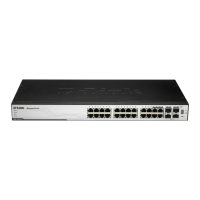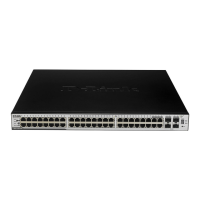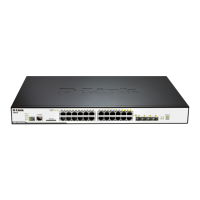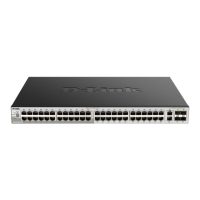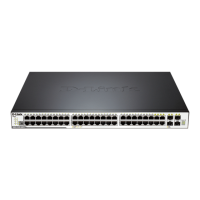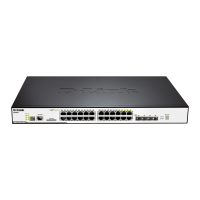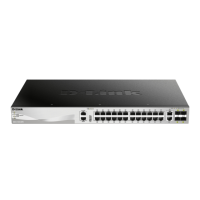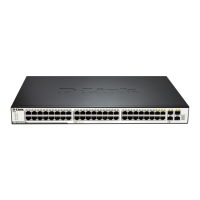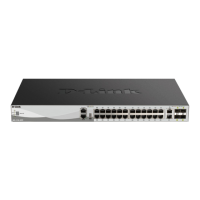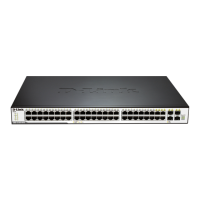Do you have a question about the D-Link DGS-3100 SERIES and is the answer not in the manual?
Provides a general overview of the DGS-3100 series and DGS-3100-24TG Gigabit Ethernet Switches.
Describes the DGS-3100 series and DGS-3100-24TG front panels and their features.
Details the methods for managing the DGS-3100 series, including Web, SNMP, and CLI.
Provides an overview of the manual's structure and chapter contents.
Identifies the target audience for the DGS-3100 series/DGS-3100-24TG User Guide.
Explains the meaning of NOTE, NOTICE, and CAUTION indicators used in the manual.
Provides essential safety guidelines for operating the system and protecting equipment.
Outlines precautions for rack stability and safe installation of components.
Explains how to access and use the Boot/Startup menu for initial configuration.
Details the procedure for downloading new software versions to the device.
Describes how to configure the serial port baud rate for terminal communication.
Explains how to assign unique Unit IDs for stacking members.
Provides instructions on how to access and use the device's web interface.
Details the different views and areas within the device's web interface.
Describes the options available within the Tool menu for device management.
Explains how to view the status information for stacked devices.
Details how to activate LED locators to find specific system devices.
Describes how to back up and restore device configuration files via HTTP or TFTP.
Explains the procedure to restore the device to its factory default settings.
Provides instructions for downloading firmware files to manage the device.
Details the method for selecting and rebooting one or all units in the system.
Explains the functionality of user interface buttons for account management.
Describes the read-only access level ('User') available on the WEB GUI.
Contains parameters for general device information and shortcuts to features.
Provides device information about specific stacking members.
Explains how to assign static or dynamic IP addresses to devices.
Explains stacking concepts, modes, and provides topics on managing stacks.
Covers configuring port properties and viewing port descriptions.
Defines ARP parameters to convert IP addresses into MAC addresses.
Details how to configure user accounts, including passwords and access rights.
Describes how to record and manage system events and error messages.
Explains how to configure Simple Network Time Protocol for accurate clock synchronization.
Details system time parameters for local hardware clock and external SNTP.
Provides instructions to globally enable or disable SNMP service.
Explains how to define SNMP views to control access to device features.
Details how to create SNMP groups and assign access control privileges.
Explains how to assign system users to SNMP groups and define authentication methods.
Describes how to manage access rights by defining communities for SNMP v1/v2c.
Contains information for defining filters for SNMP traps sent to specific hosts.
Explains how to define a unique identifier for SNMP v3 implementations.
Details parameters for defining SNMP notification parameters.
Allows enabling DHCP relay and defining DHCP relay servers.
Explains how to configure DHCP Local Relay by enabling the feature.
Enables or disables automatic download of image and configuration files from DHCP.
Manages the two software images in flash memory for bootup and backup.
Allows users to enable or disable Telnet service on the device.
Used to define time-based ACLs and configure time ranges for PoE port settings.
Enables users to configure access to the device via a serial port.
Enhances network throughput and reduces CPU utilization by enabling larger payloads.
Covers IEEE 802.1p Priority, VLAN description, and 802.1Q VLANs.
Allows a port to be defined as untagged in one VLAN and tagged in multiple VLANs.
Configures GARP VLAN Registration Protocol for automatic distribution of VLAN membership.
Contains information for assigning ports to LAGs and defining LAG parameters.
Allows frames belonging to unknown VLAN groups to pass through the switch.
Enables administrators to force traffic from source ports to bypass FDB.
Details Link Aggregation Control Protocol settings for relevant links.
Explains IGMP snooping for efficient multicast traffic forwarding.
Explains Multicast Listener Discovery snooping for IPv6 multicast routers.
Allows traffic analysis and monitoring by copying traffic to a designated 'target' port.
Provides tree topography for bridges, preventing loops and ensuring single paths.
Contains information for configuring Unicast and Multicast filtering.
Allows troubleshooting and enhancing network management by discovering neighbors.
Enables configuration of ports to carry IP voice traffic on a specific VLAN.
Explains IEEE 802.1p priority tagging for managing network traffic.
Details the switch's four priority queues and their mapping to IEEE 802.1p tags.
Allows network managers to define bandwidth settings for a specified interface.
Limits multicast, broadcast, and unknown unicast frames to prevent network storms.
Classifies traffic by assigning priority values per port for packets without a priority tag.
Assigns priority tags to traffic classes (queues) for network traffic management.
Defines the QoS scheduling forwarding scheme, including Strict and WRR modes.
Maps DSCP settings to traffic queues, allowing packet priority assignment.
Configures Multi-Layer Class of Service settings via Access Control Lists.
Sets network alarms to protect the CPU from attacks based on threshold levels.
Applies restrictions on managing the device from remote stations by IP address.
Limits port access to users with specific MAC addresses for enhanced network security.
Provides limited network access to authorized ports via port-based authorization.
Authenticates users per-port/per-MAC basis via an external RADIUS server.
Allows enabling or disabling forwarding of EAP packets to an authentication server.
Provides secure communication path using authentication, digital signatures, and encryption.
Enables secure login to the network from remote locations over an insecure network.
Allows network administrators to enable public key for SSH authentication encryption.
Permits administrators to assign authentication methods for user authentication.
Defines RADIUS or TACACS+ server information for network user authentication.
Allows network users to log in to the device using specified authentication methods.
Assigns user privileges using authentication methods for network access.
Allows administrators to configure the local enabled password for network access.
Prevents man-in-the-middle attacks by inspecting ARP requests and responses.
Provides specific information for stacked devices, including master and member IDs.
Displays information about the system's CPU utilization over time.
Contains port utilization information for specific ports to view port statistics.
Displays packets received by the switch, grouped and classed by size.
Contains information about packets transmitted through device ports.
Displays counts of Unicast, Multicast, and Broadcast packets received.
Provides information about packets transmitted through device ports.
Provides RADIUS authentication session details, including initiated sessions and status.
Provides information regarding ARP VLANs, mapping IP to MAC addresses.
Displays which ports are connected to MLD routers, static or dynamic.
Displays which ports are connected to routers, static or dynamic.
Displays information regarding device sessions initiated by system users.
Contains vital IGMP group information, including IP and MAC addresses.
Contains vital MLD group information, including IP and MAC addresses.
Explains how to view and manage MAC address entries in the MAC address table.
Provides information about system logs, including boot, port operations, and user logins.
Improves energy consumption by reducing power on short cables or link down.
Displays basic operating environment information like temperature and ventilation.
Displays error counters for received and transmitted packets.
Performs tests on copper cables to identify errors and cable characteristics.
Contains information about the system's CPU utilization related to PoE ports.
Configures port utilization information for specific ports related to PoE system settings.
Describes the two ways to configure Access Control Lists via WEB GUI.
Assists in configuring ACLs intuitively, creating profiles and rules automatically.
Provides information for configuring ACL Profiles manually.
Details the conditions that can be defined as Access Rules for ACLs.
Illustrates the pin allocation for the RJ-45 Ethernet ports.
Illustrates the pin allocation for the HDMI connector used for stacking.
Provides a general overview of the DGS-3100 series and DGS-3100-24TG Gigabit Ethernet Switches.
Describes the DGS-3100 series and DGS-3100-24TG front panels and their features.
Details the methods for managing the DGS-3100 series, including Web, SNMP, and CLI.
Provides an overview of the manual's structure and chapter contents.
Identifies the target audience for the DGS-3100 series/DGS-3100-24TG User Guide.
Explains the meaning of NOTE, NOTICE, and CAUTION indicators used in the manual.
Provides essential safety guidelines for operating the system and protecting equipment.
Outlines precautions for rack stability and safe installation of components.
Explains how to access and use the Boot/Startup menu for initial configuration.
Details the procedure for downloading new software versions to the device.
Describes how to configure the serial port baud rate for terminal communication.
Explains how to assign unique Unit IDs for stacking members.
Provides instructions on how to access and use the device's web interface.
Details the different views and areas within the device's web interface.
Describes the options available within the Tool menu for device management.
Explains how to view the status information for stacked devices.
Details how to activate LED locators to find specific system devices.
Describes how to back up and restore device configuration files via HTTP or TFTP.
Explains the procedure to restore the device to its factory default settings.
Provides instructions for downloading firmware files to manage the device.
Details the method for selecting and rebooting one or all units in the system.
Explains the functionality of user interface buttons for account management.
Describes the read-only access level ('User') available on the WEB GUI.
Contains parameters for general device information and shortcuts to features.
Provides device information about specific stacking members.
Explains how to assign static or dynamic IP addresses to devices.
Explains stacking concepts, modes, and provides topics on managing stacks.
Covers configuring port properties and viewing port descriptions.
Defines ARP parameters to convert IP addresses into MAC addresses.
Details how to configure user accounts, including passwords and access rights.
Describes how to record and manage system events and error messages.
Explains how to configure Simple Network Time Protocol for accurate clock synchronization.
Details system time parameters for local hardware clock and external SNTP.
Provides instructions to globally enable or disable SNMP service.
Explains how to define SNMP views to control access to device features.
Details how to create SNMP groups and assign access control privileges.
Explains how to assign system users to SNMP groups and define authentication methods.
Describes how to manage access rights by defining communities for SNMP v1/v2c.
Contains information for defining filters for SNMP traps sent to specific hosts.
Explains how to define a unique identifier for SNMP v3 implementations.
Details parameters for defining SNMP notification parameters.
Allows enabling DHCP relay and defining DHCP relay servers.
Explains how to configure DHCP Local Relay by enabling the feature.
Enables or disables automatic download of image and configuration files from DHCP.
Manages the two software images in flash memory for bootup and backup.
Allows users to enable or disable Telnet service on the device.
Used to define time-based ACLs and configure time ranges for PoE port settings.
Enables users to configure access to the device via a serial port.
Enhances network throughput and reduces CPU utilization by enabling larger payloads.
Covers IEEE 802.1p Priority, VLAN description, and 802.1Q VLANs.
Allows a port to be defined as untagged in one VLAN and tagged in multiple VLANs.
Configures GARP VLAN Registration Protocol for automatic distribution of VLAN membership.
Contains information for assigning ports to LAGs and defining LAG parameters.
Allows frames belonging to unknown VLAN groups to pass through the switch.
Enables administrators to force traffic from source ports to bypass FDB.
Details Link Aggregation Control Protocol settings for relevant links.
Explains IGMP snooping for efficient multicast traffic forwarding.
Explains Multicast Listener Discovery snooping for IPv6 multicast routers.
Allows traffic analysis and monitoring by copying traffic to a designated 'target' port.
Provides tree topography for bridges, preventing loops and ensuring single paths.
Contains information for configuring Unicast and Multicast filtering.
Allows troubleshooting and enhancing network management by discovering neighbors.
Enables configuration of ports to carry IP voice traffic on a specific VLAN.
Explains IEEE 802.1p priority tagging for managing network traffic.
Details the switch's four priority queues and their mapping to IEEE 802.1p tags.
Allows network managers to define bandwidth settings for a specified interface.
Limits multicast, broadcast, and unknown unicast frames to prevent network storms.
Classifies traffic by assigning priority values per port for packets without a priority tag.
Assigns priority tags to traffic classes (queues) for network traffic management.
Defines the QoS scheduling forwarding scheme, including Strict and WRR modes.
Maps DSCP settings to traffic queues, allowing packet priority assignment.
Configures Multi-Layer Class of Service settings via Access Control Lists.
Sets network alarms to protect the CPU from attacks based on threshold levels.
Applies restrictions on managing the device from remote stations by IP address.
Limits port access to users with specific MAC addresses for enhanced network security.
Provides limited network access to authorized ports via port-based authorization.
Authenticates users per-port/per-MAC basis via an external RADIUS server.
Allows enabling or disabling forwarding of EAP packets to an authentication server.
Provides secure communication path using authentication, digital signatures, and encryption.
Enables secure login to the network from remote locations over an insecure network.
Allows network administrators to enable public key for SSH authentication encryption.
Permits administrators to assign authentication methods for user authentication.
Defines RADIUS or TACACS+ server information for network user authentication.
Allows network users to log in to the device using specified authentication methods.
Assigns user privileges using authentication methods for network access.
Allows administrators to configure the local enabled password for network access.
Prevents man-in-the-middle attacks by inspecting ARP requests and responses.
Provides specific information for stacked devices, including master and member IDs.
Displays information about the system's CPU utilization over time.
Contains port utilization information for specific ports to view port statistics.
Displays packets received by the switch, grouped and classed by size.
Contains information about packets transmitted through device ports.
Displays counts of Unicast, Multicast, and Broadcast packets received.
Provides information about packets transmitted through device ports.
Provides RADIUS authentication session details, including initiated sessions and status.
Provides information regarding ARP VLANs, mapping IP to MAC addresses.
Displays which ports are connected to MLD routers, static or dynamic.
Displays which ports are connected to routers, static or dynamic.
Displays information regarding device sessions initiated by system users.
Contains vital IGMP group information, including IP and MAC addresses.
Contains vital MLD group information, including IP and MAC addresses.
Explains how to view and manage MAC address entries in the MAC address table.
Provides information about system logs, including boot, port operations, and user logins.
Improves energy consumption by reducing power on short cables or link down.
Displays basic operating environment information like temperature and ventilation.
Displays error counters for received and transmitted packets.
Performs tests on copper cables to identify errors and cable characteristics.
Contains information about the system's CPU utilization related to PoE ports.
Configures port utilization information for specific ports related to PoE system settings.
Describes the two ways to configure Access Control Lists via WEB GUI.
Assists in configuring ACLs intuitively, creating profiles and rules automatically.
Provides information for configuring ACL Profiles manually.
Details the conditions that can be defined as Access Rules for ACLs.
Illustrates the pin allocation for the RJ-45 Ethernet ports.
Illustrates the pin allocation for the HDMI connector used for stacking.
| Type | Managed |
|---|---|
| Layer | Layer 2+ |
| Ports | 10/100/1000BASE-T |
| SFP Ports | 2 or 4 (depends on the model) |
| Additional SFP Ports | No |
| VLANs | Yes |
| Stacking | Yes, Physical Stacking |
| QoS | Yes |
| Jumbo Frame Support | Up to 9K bytes |
| Management | Web-based |
| Operating Temperature | 0°C to 40°C |
| Humidity | 10% to 90% non-condensing |
| Standards Compliance | IEEE 802.3, IEEE 802.3u, IEEE 802.3ab, IEEE 802.3z, IEEE 802.3x, IEEE 802.1D, IEEE 802.1w, IEEE 802.1s, IEEE 802.1Q, IEEE 802.1p |
| Model | DGS-3100 SERIES |
| Storage Temperature | -40°C to 70°C |
